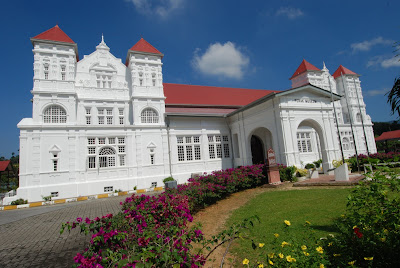Located in Kampung Kuala Dal, Padang Rengas about 4.8 kilometers from the Royal Town of Kuala Kangsar and only 2 km from the toll plaza in Kuala Kangsar Plus. The uniqueness of this mosque can be seen in a similar structural design as cage birds. The mosque is a whole wall made of woven bamboo that oil is called "the wall Tepas / Tepus" art of softness kelarai hand woven pattern of influence "arabes' on mosque walls rise to the aesthetic value of buildings is the main attraction to anyone who looked. Work on the wall Tepas weaving is done by some local people including the length of Noh, Gadoh Ngah, Wan Ngah Ibrahim and Kulop. There are 20 windows decorated with carved leaves two "punch directly, not martial" patterned bean shoots, the crescent and star. Roof of the mosque is also very unique because they had no cause seems to spreading flat roof flat roof is not influenced by the Palace Memories with 'plane' highly significant gradient.
Ihsaniah Alexandria Mosque was built in 1936. The construction was financed by Al-Marhum Paduka Seri Sultan Iskandar Shah, the Sultan of Perak on the 30th. Opening plaques obtained board at the mosque recorded the opening ceremony was held on Friday 10th Muharram in the year 1356H corresponding February 11, 1938. It was built after the Sultan of discharging a vow to build a mosque when one of his son recovers from the ill. His Majesty's intention arises when you see the local community who perform the prayer at the madrassa in the village after returning from a picnic at the Lata Bubu. Hence, the Sultan vowed to contribute a sum of RM 8,000.00 to build a new mosque on a piece of land grant endowment Skipper Abdul Shukur bin Mohamad Ali. The construction of this mosque was built by Chinese craftsmen and assisted by local residents as cooperate. The architecture of this mosque is said to come from his own inspired strongly influenced architectural features of the Palace Memories at Bukit Chandan, Kuala Kangsar. Variety of wallpapers and wall in the mosque Tepas also carved and woven by local residents. The mosque is not used in 1976, after a new mosque known as Masjid Al-Wahidiah built.
On the importance of historical buildings and unique architecture, the Department of National Heritage has been carrying out conservation work in December 2008. Among the problems faced in this project is the preparation of Tepas wall due to the absence of skilled artisans making and lack of material woven bamboo manufacturers, that the local oil to make a wall kelarai. Therefore, the Department of National Heritage has to fetch the making wicker and bamboo resources of Perlis according to the original. This conservation work has been carried out using a systematic work procedures to maintain the authenticity of the original architecture.
articel source: http://www.heritage.gov.my/










